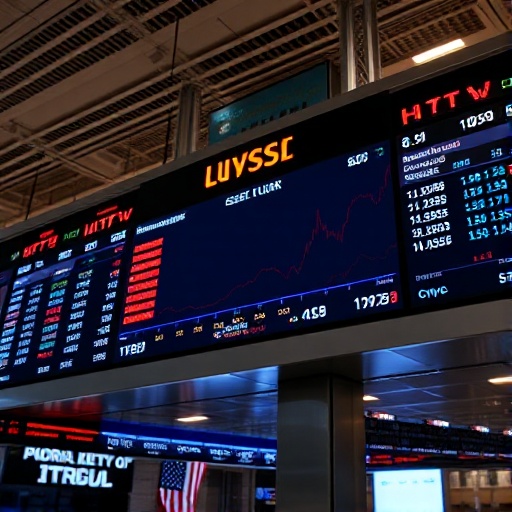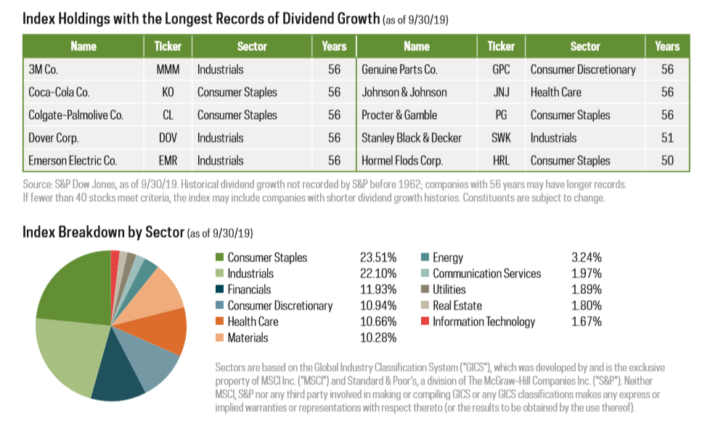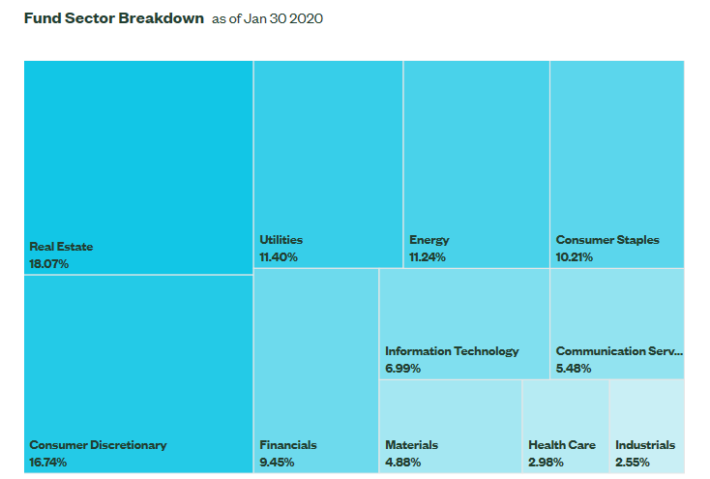Published on January 31st, 2020 by Bob Ciura
We believe dividend growth investors can generate superior long-term returns by investing in high-quality dividend stocks, such as the Dividend Aristocrats. The Dividend Aristocrats are a group of 64 stocks in the S&P 500 Index, that have each raised their dividends for at least 25 years or longer.
Investors can buy high-quality dividend growth stocks such as the Dividend Aristocrats individually, or through exchange-traded funds. ETFs have become much more popular in the past five years, especially when compared to more expensive mutual funds.
With this in mind, we created a downloadable Excel list of dividend ETFs that we believe are the most attractive for income investors. We have also included the dividend yield, expense ratio, and average price-to-earnings ratio of the ETF (if available).
You can download your full list of 20+ dividend-focused ETFs by clicking on the link below:
Dividend ETFs could be a worthwhile addition to a dividend growth investor’s portfolio, especially for investors looking for diversification and simplicity.
This article will discuss why income investors who do not want to buy individual stocks, should consider dividend ETFs. We also discuss our top picks among the major dividend ETFs.
ETF Basics
First, investors should get to know the basics of exchange-traded funds. ETFs are similar to mutual funds, in that they allow investors to purchase shares of a basket of stocks at once. In this way, ETFs and mutual funds both provide instant diversification benefits. ETFs typically track an index, but can take on a variety of investment strategies.
ETFs come in all shapes and sizes–including small-caps, mid-caps, and large-caps; growth ETFs, value ETFs, or income ETFs; and ETFs that invest in specific market sectors or industries. Some ETFs invest in U.S.-based companies, while other ETFs invest in the international markets. There are also ETFs across various asset classes, including equity ETFs, bond ETFs, currency ETFs, or ETFs that invest in Master Limited Partnerships (MLPs) or Real Estate Investment Trusts (REITs).
Certain ETFs also deploy the use of leverage, to amplify returns. However, investors should understand that use of leverage can backfire. There are also inverse ETFs that allow investors to take an opposite position of a given index or sector.
The largest ETF in terms of assets under management is the SPDR S&P 500 ETF (SPY), which had AUM of just over $311 billion as of January 29th, 2020. ETFs like SPY provide investors with immediate diversification benefits, which some investors prefer to investing in individual stocks. Buying individual stocks requires investors conduct proper due diligence of that specific company’s business model, growth potential, and stock valuation.
Prior to the ETF boom over the past decade, investors looking to hold baskets of stocks purchased mutual funds. But many mutual funds had exorbitant fees associated with investing, such as front-end fees, and high annual fees of 1% or more. These fees serve no purpose for the investor, and can significantly eat away at returns over the years. ETFs became highly popular, as many carried much lower fees than comparable mutual funds.
SPY has an annual expense ratio of just 0.095%, which can help investors save a great deal of money over time. Consider the following example of an investor who purchases $10,000 in SPY, and earns an average rate of return of 8% per year for 30 years. Including the 0.095% annual fee, this investor would end up with a portfolio value of just over $98,000.
Now assume the investor instead placed the original $10,000 into a comparable mutual fund with the same holdings, but the mutual fund charged an annual expense ratio of 1%. In 30 years, this investor would have a portfolio worth just over $76,000 after annual fees are accounted for–approximately $22,000 less than if the investor had purchased SPY instead.
In addition to lower fees, ETFs also allow investors greater liquidity. ETFs are traded throughout the day, just like stocks. This compares favorably to mutual funds, which are priced only once per day, after the market close.
This explains the ETF boom over the past 10 years, which is not expected to slow any time soon. Asset managers have engaged in a price war of sorts for the past several years, being forced to slash fees in order to retain clients. SPY is arguably the best way to invest in the S&P 500 through ETFs. For income investors looking for a higher yield, there are also dividend-focused ETFs that are highly attractive.
The Dividend Aristocrats ETF
There are many good reasons for income investors to consider the Dividend Aristocrats. Investing naturally carries risk, but the Dividend Aristocrats have maintained long track records of consistent dividend increases. They have also proven to generate higher returns than the overall market in the past decade.
Over the past 10 years, the Dividend Aristocrats outperformed the broader S&P 500 Index by 1 full percentage point (13.9% total annualized returns for the Dividend Aristocrats to 12.9% for the S&P). The Dividend Aristocrats generated stronger total returns than the broader market index, with lower volatility as well.
We believe the Dividend Aristocrats widely possess durable competitive advantages, leadership positions in their specific industries, and long-term growth potential. These qualities allow them to raise their dividends each year without interruption.
Many Dividend Aristocrats have increased their dividends for 50 years or longer. The Dividend Aristocrats list is diversified across market sectors, as indicated by the image below:
Source: NOBL Fact Sheet
We recommend investors purchase individual Dividend Aristocrats with expected returns near or above 10% per year over the next five years. We provide full reports which detail our expected returns for hundreds of stocks, including the Dividend Aristocrats, in the Sure Analysis Research Database.
But for many investors, ETFs could be a suitable alternative. If an investor would rather own all the Dividend Aristocrats at once, the ProShares S&P 500 Dividend Aristocrats ETF (NOBL) is the best choice.
NOBL is the major ETF that specifically tracks the Dividend Aristocrats. NOBL has net assets of approximately $5.5 billion, with a Morningstar rating of four stars. As previously mentioned, one of the big selling points for ETFs is their low expense ratios. Indeed, NOBL has a very reasonable annual expense ratio of 0.35%.
Not surprisingly, NOBL has a diversified list of holdings. As of January 29th, it owned 57 Dividend Aristocrats. Standard & Poor’s recently added 7 stocks to the list of Dividend Aristocrats for 2020, bringing the total to 64, and it is assumed that NOBL will add those 7 to its holdings soon.
NOBL has performed very well, in relation to the broader market. For example, in the past 5 years through 9/30/19, NOBL produced total annual returns of 11.3%, compared with 10.8% annual returns for the S&P 500 Index. NOBL looks like an attractive ETF for investors looking to purchase a dividend-growth directed ETF. The fund has an average price-to-earnings ratio of 18.5, which is a reasonable average valuation that indicates fund holdings are not excessively overvalued right now.
An ETF For Even Higher Income
One potential downside of NOBL is that the dividend yield of the fund is 2.5%; while this beats the ~2% average dividend yield of the S&P 500, investors can find many individual Dividend Aristocrats with significantly higher yields.
For example, AT&T (T), AbbVie (ABBV), and Exxon Mobil (XOM) are all Dividend Aristocrats, and all have current dividend yields above 5%–more than double the yield of the NOBL ETF. Investors willing to take the risks associated with buying individual stocks can generate much higher portfolio income by focusing on the highest-yielding Dividend Aristocrats.
Investors looking for a higher yield than what NOBL provides could consider SPDR Portfolio S&P 500 High Dividend ETF (SPYD). This ETF has a much higher yield of 4.5%, and it also has a very low annual expense ratio of 0.07%. SPYD has just over $2 billion in assets under management. The ETF is diversified, but the real estate, consumer discretionary, and utilities sectors represent a large portion of holdings.
Source: SPYD Fact Sheet
The fund objective is to hold ~80 of the highest-yielding stocks in the S&P 500. The average market cap of the stock holdings is $40.5 billion, with an average price-to-earnings ratio of 14.3. This ETF has greater appeal for value and income investors than NOBL, due to its higher yield and lower average P/E ratio.
That said, the holdings of SPYD are not quite the blue-chip dividend stocks that comprise NOBL’s holdings. Most stocks held by SPYD do not possess the same track record of annual dividend increases as the Dividend Aristocrats. For example, the top five holdings of SPYD are Newell Brands (NWL), Western Union (WU), Nordstrom Inc. (JWN), Southern Company (SO), and Entergy Corporation (ETR).
These are all high-yield stocks, but none of them is on the list of Dividend Aristocrats. Therefore, the general takeaway for SPYD is that investors can collect a higher dividend yield, but are sacrificing business quality somewhat in return.
Final Thoughts
We are big proponents of selectively purchasing high-quality dividend growth stocks, such as the Dividend Aristocrats and Dividend Kings (which have raised dividends for 50+ years), particularly when they are undervalued. But buying individual stocks requires thorough research into the company’s specific business model, growth outlook, and various company-specific risks.
For investors who want to simplify the process of buying dividend growth stocks, ETFs could be an attractive option. Investors can attain instant diversification benefits by purchasing an ETF, although the trade-off is that ETFs charge annual fees that reduce shareholder returns. And, many ETFs have lower yields than can be generated by investing in individual stocks.
Investors who decide to go the ETF route may find NOBL to be a good way to invest in all the Dividend Aristocrats at once, while SPYD is an appealing choice for income investors looking for high yields.







